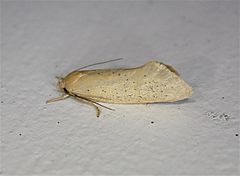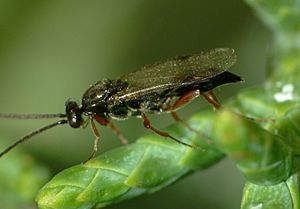Tingena armigerella facts for kids
Quick facts for kids Tingena armigerella |
|
|---|---|
 |
|
| Scientific classification | |
| Kingdom: | |
| Phylum: | |
| Class: | |
| Order: | |
| Family: |
Oecophoridae
|
| Genus: | |
| Species: |
T. armigerella
|
| Binomial name | |
| Tingena armigerella (Walker, 1864)
|
|
| Synonyms | |
|
|
Tingena armigerella is a small moth that belongs to the Oecophoridae family. This special moth is only found in New Zealand, mainly on the North Island. Its young, called larvae, like to eat dead leaves and other plant bits found on the ground.
Contents
About This Moth's Name
This moth was first described in 1864 by a scientist named Francis Walker. He originally gave it the name Oecophora armigerella.
Later, in 1928, George Hudson wrote about and drew this moth in his book, The Butterflies and Moths of New Zealand. At that time, he called it Borkhausenia armigerella.
Finally, in 1988, another scientist, John S. Dugdale, placed this moth into the group (or genus) called Tingena. He also figured out that another moth, Tingena bifaciella, was actually the same species as Tingena armigerella.
What Does This Moth Look Like?
This moth is mostly a shiny yellow color. Its feelers, called palpi, are almost twice as long as its head is wide. The lower part of its body, called the abdomen, and its back wings are a dark, grayish color.
Its front wings are fairly wide and have many tiny dark spots. The part of the wing closest to its body is also a bit dark. These moths are often confused with other yellow moths, but T. armigerella has special dark scales on its wings that help tell it apart.
Where Does This Moth Live?
Tingena armigerella is found only in New Zealand. It lives all over the North Island. Scientists think that any sightings of this moth in the South Island might be mistakes, as it looks very similar to other yellow moths found there.
What Do They Eat and Where Do They Live?
The young moths, or larvae, of Tingena armigerella eat plant litter. This is the dead leaves and other plant material found on the forest floor. They especially like to live in Nothofagaceae forests.
These larvae build their homes by tying two dead leaves together with their silk. They live in this cozy shelter, usually found between the dry leaves on top and the moist soil below. From their shelter, they munch on the dead leaves.
Who Are Their Enemies?
One of the enemies of Tingena armigerella larvae is a special kind of parasitic wasp called Fustiserphus intrudens. This wasp lays its eggs on or inside the moth larvae, and when the wasp eggs hatch, the young wasps feed on the moth larvae.


